As you either have or will read elsewhere in this issue, the London Show was
great. I have my own way of measuring the success of a show, outside of all the
normal measures of attendance, tables, sales, etc. I measure shows by the number
of pictures I take. By that measure, London was one of the best shows I've been
to in years. I don't think I got to take my head out of my light box until about
3:00 p.m. on Saturday afternoon and I was back at it again on Sunday. Following
are some of the pictures I took, along with explanations as required. Almost no
matter what you collect, I think you'll find something new in this bunch.
I have to start with the "new find" of the year. As announced
several months ago in CJ, the first known example of a CD 139, Combination
Safety with SDP, that's right, Sharp Drip Points, was put up for auction at
London. Below are pictures from the front and back. Embossing is as
follows:
(F-Skirt) COMBINATION/SAFETY
(R-Skirt) PAT. APPL'D FOR
It seems almost incredible that a style as rare as CD 139 (less than a dozen
that I know of) has been found with and without drip points and with an
embossing error (SAFTY).
For those, like me, who have never owned a Combination Safety and would like
to, these three variations found to date indicate that at least at one time,
there were probably enough for each of us. Keep looking. The one with drips came
out of a collection of "ONE" insulator.
Well, that ought to take care
of the CD specialists. How about a piece for the power collectors? Pictured
below is what would appear to be your standard CD 259 Cable.

Not so!! This one
is base embossed. Not very unusual, you say? Right, but guess what it says on the base:
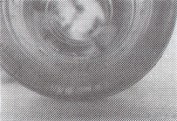
PATENTS APP'D FOR
I think that makes it a candidate for the first Oakman Cable. This piece came
out of the collection of Sid Marques and currently belongs to Dwayne Anthony.
I'm embarrassed to say that I saw Sid's collection twice before he sold it, and
I never picked up that CD 259 to check the embossing. I'm reminded of my own
advice: "Look at every piece. You, never know what's hiding in even the
most modest collection or table of so-caned common insulators." Thanks to
Dwayne for bringing the piece all the way from California so I could get a
picture.
Next is the continuing saga of the CD 113, Hemingray embossings. I have
two to share with you. First is one of my favorite embossing errors. A quick
look at this piece and you don't necessarily discover what's wrong. Look again.
It's embossed HEMINGRAY/NO 9 on a Hemingray No. 12 style. I saw one of these about 20 years ago, and I don't have another encounter recorded since.
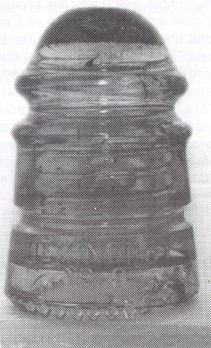
I
remember telling Charlie Angevine, Mr. Hemingray No.9, about that one, and I
remember my surprise at his lack of interest in it. How was I to know he only
collected the style (CD 106), not the embossing. Roger Lucas, the current owner
of this piece, specializes in embossing errors. He brought this beauty for me to
photograph, but also in the hopes of upgrading it. Note, there is some minor
base damage. I told him I thought he was very fortunate to have one in any
condition, but if he happened to find another, I knew there'd be a bunch of
folks standing in line to get the "damaged" one. Roger, thanks for
sharing.
Bill Meier continues his search for new Hemingrays to add to his
collection. The embossing error he showed me at the Eastern Regional last year
(see Mac's Believe It Or Not, November, 1992) now has a cousin. Please note the
beginning of a second line of embossing with the letters "MA" visible.
Doesn't it drive you crazy that both "MAY 2nd, 1893" and "MADE IN
U.S.A." begin with "MA"? I can make a case for either. especially
since I can see what appears to be mold rework under both lines of embossing.
I'll let you be the judge of that one. Keep 'em coming, Bill.
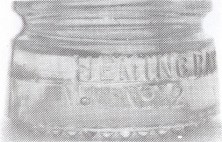
Attention, porcelain collectors. Pictured here is the only known (I always
worry when I say that, but if I end up being proven wrong, we all learn
something) example of the Slusser's Patent. As you can see from the side and top
views, this insulator has features and functionality similar to the Harloe claw
(CD's 109.5 and 206.5). Embossed on the dome of the insulator are the words
"SLUSSER INSULATOR", leaving little doubt as to its authenticity. This
beauty came out of the collection of long time porcelain specialist John Hall
and currently belongs to Jerry Turner.
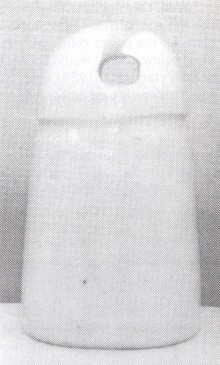
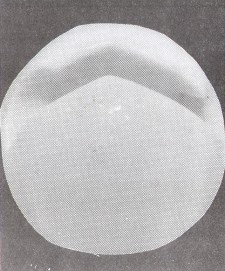
The editor says I have to stop this
section of my London show report soon, so I'll wind up with a brief trip from
the sublime to the ridiculous. A collector (who's name I didn't write down)
brought in the porcelain piece pictured below. Take a look at it for a minute
before reading on.
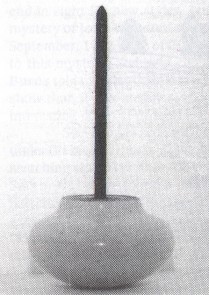
What do you think it is?
Note the embossing, "LAPP INSULATOR CO./LE ROY N.Y."

Well, we came up with toilet part and a few other suggestions before we were
told it was a tee marker for a golf course. Easy to see once you've been told,
right?!? Is this the first indication that Lapp was into golf, or did this
porcelain item have another function before it showed up on the first tee? We
always end up with more questions than answers.
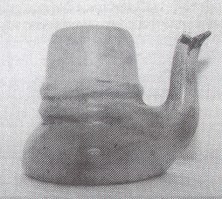
Finally, we have a picture
providing the definitive explanation for why the threadless jewel from the Confederacy became known as the teapot.
Lest anyone think that we are intentionally perpetrating a hoax on the insulator public, this one is
clearly as phony as the proverbial three dollar bill. It is a product of the
imagination of Bob Harding who saw the possibilities of matching the spout from
an old teapot and a 'spoutless' porcelain teapot insulator. Bob's repair work is
exceptional, and he is now the proud owner of a real conversation piece. I
thought you'd get a good laugh out of this creation.
It's hard, Believe It Or Not!, as I sit here finishing up this section of my show report that I have just
13 more days to work for Ameritech. By the time you read this, I will be officially
retired from the Telephone Company, where I've spent all of my working life
since 1962. The reason I mention it here is that "The Editor" says I
have to be a regular contributor to the magazine now that I'm going to have all
of this spare time. Keep your eyes peeled. Next month will be the remainder of
the London finds and the beginning of my "Tales from British Columbia -- Mac
hits the Collins Line."


































































